Numerical Investigation of a Designed-Inlet Optofluidic Beam Splitter for Split-Angle and Transmission Improvement
Abstract
:1. Introduction
2. GRIN Beam Splitter Design
3. Numerical Simulations and Geometrical Parameter Analysis
4. Fabrication and Experiment Apparatus
5. Results and Discussion
5.1. Test of Parameters of Numerical Simulation
5.2. Comparison of Numerical Results and Experiment Results
5.3. Influence of the Geometry of the Beam Splitter
5.4. Effect of the Ratio of Flow Rates
6. Conclusions
Author Contributions
Funding
Data Availability Statement
Acknowledgments
Conflicts of Interest
References
- Song, C.; Tan, S.H. A perspective on the rise of optofluidics and the future. Micromachines 2017, 8, 152. [Google Scholar] [CrossRef] [Green Version]
- Erickson, D.; Sinton, D.; Psaltis, D. Optofluidics for energy applications. Nat. Photonics 2011, 5, 583–590. [Google Scholar] [CrossRef]
- Lei, L.; Wang, N.; Zhang, X.M.; Tai, Q.; Tsai, D.P.; Chan, H.L.W. Optofluidic planar reactors for photocatalytic water treatment using solar energy. Biomicrofluidics 2010, 4, 043004. [Google Scholar] [CrossRef] [PubMed] [Green Version]
- Fan, X.D.; White, I.M. Optofluidic microsystems for chemical and biological analysis. Nat. Photonics 2011, 5, 591–597. [Google Scholar] [CrossRef]
- Myers, F.B.; Lee, L.P. Innovations in optical microfluidic technologies for point-of-care diagnostics. Lab Chip 2008, 8, 2015–2031. [Google Scholar] [CrossRef] [PubMed]
- Weber, E.; Vellekoop, M.J. Optofluidic micro-sensors for the determination of liquid concentrations. Lab Chip 2012, 12, 3754–3759. [Google Scholar] [CrossRef] [PubMed]
- Nguyen, N.-T. Micro-optofluidic lenses: A review. Biomicrofluidics 2010, 4, 031501. [Google Scholar] [CrossRef] [PubMed] [Green Version]
- Tang, X.; Liang, S.; Li, R. Design for controllable optofluidic beam splitter. Photonics Nanostruct. Fundam. Appl. 2015, 18, 23–30. [Google Scholar] [CrossRef]
- Seow, Y.C.; Liu, A.Q.; Chin, L.K.; Li, X.C.; Huang, H.J.; Cheng, T.H.; Zhou, X.Q. Different curvatures of tunable liquid microlens via the control of laminar flow rate. Appl. Phys. Lett. 2008, 93, 084101. [Google Scholar] [CrossRef]
- Shi, J.; Stratton, Z.; Lin, S.C.S.; Huang, H.; Huang, T.J. Tunable optofluidic microlens through active pressure control of an air–liquid interface. Microfluid. Nanofluid. 2009, 9, 313–318. [Google Scholar] [CrossRef]
- Mao, X.; Waldeisen, J.R.; Juluri, B.K.; Huang, T.J. Hydrodynamically tunable optofluidic cylindrical microlens. Lab Chip 2007, 7, 1303–1308. [Google Scholar] [CrossRef] [PubMed]
- Mao, X.; Lin, S.C.S.; Lapsley, M.I.; Shi, J.; Juluri, B.K.; Huang, T.J. Tunable liquid gradient refractive index (L-GRIN) lens with two degrees of freedom. Lab Chip 2009, 9, 2050–2058. [Google Scholar] [CrossRef]
- Mishra, K.; Murade, C.; Carreel, B.; Roghair, I.; Oh, J.M.; Manukyan, G.; van den Ende, D.; Mugele, F. Optofluidic lens with tunable focal length and asphericity. Sci. Rep. 2014, 4, 6378. [Google Scholar] [CrossRef] [PubMed] [Green Version]
- Le, Z.; Sun, Y.; Du, Y. Liquid gradient refractive index microlens for dynamically adjusting the beam focusing. Micromachines 2015, 6, 1984–1995. [Google Scholar] [CrossRef] [Green Version]
- Miccio, L.; Memmolo, P.; Merola, F.; Netti, P.A.; Ferraro, P. Red blood cell as an adaptive optofluidic microlens. Nat. Commun. 2015, 6, 6502. [Google Scholar] [CrossRef] [PubMed] [Green Version]
- Hamilton, E.S.; Ganjalizadeh, V.; Wright, J.G.; Schmidt, H.; Hawkins, A.R. 3D hydrodynamic focusing in microscale optofluidic channels formed with a single sacrificial layer. Micromachines 2020, 11, 349. [Google Scholar] [CrossRef] [PubMed] [Green Version]
- Song, C.; Nguyen, N.T.; Asundi, A.K.; Tan, S.H. Tunable micro-optofluidic prism based on liquid-core liquid-cladding configuration. Opt. Lett. 2010, 35, 327–329. [Google Scholar] [CrossRef] [PubMed] [Green Version]
- Xiong, S.; Liu, A.Q.; Chin, L.K.; Yang, Y. An optofluidic prism tuned by two laminar flows. Lab Chip 2011, 11, 1864–1869. [Google Scholar] [CrossRef]
- Wolfe, D.B.; Conroy, R.S.; Garstecki, P.; Mayers, B.T.; Fischbach, M.A.; Paul, K.E.; Prentiss, M.; Whitesides, G.M. Dynamic control of liquid-core/liquid-cladding optical waveguides. Proc. Natl. Acad. Sci. USA 2004, 101, 12434–12438. [Google Scholar] [CrossRef] [Green Version]
- Wolfe, D.B.; Vezenov, D.V.; Mayers, B.T.; Whitesides, G.M.; Conroy, R.S.; Prentiss, M.G. Diffusion-controlled optical elements for optofluidics. Appl. Phys. Lett. 2005, 87, 181105. [Google Scholar] [CrossRef]
- Schmidt, H.; Hawkins, A.R. Optofluidic waveguides: I. Concepts and implementations. Microfluid. Nanofluid. 2008, 4, 3–16. [Google Scholar] [CrossRef] [Green Version]
- Schmidt, H.; Hawkins, A.R. Optofluidic waveguides: II. Fabrication and structures. Microfluid. Nanofluid. 2007, 4, 17–32. [Google Scholar]
- Yang, Y.; Liu, A.Q.; Chin, L.K.; Zhang, X.M.; Tsai, D.P.; Lin, C.L.; Lu, C.; Wang, G.P.; Zheludev, N.I. Optofluidic waveguide as a transformation optics device for lightwave bending and manipulation. Nat. Commun. 2012, 3, 651. [Google Scholar] [CrossRef] [Green Version]
- Yang, Y.; Chin, L.K.; Tsai, J.M.; Tsai, D.P.; Zheludev, N.I.; Liu, A.Q. Transformation optofluidics for large-angle light bending and tuning. Lab Chip 2012, 12, 3785–3790. [Google Scholar] [CrossRef]
- Li, L.; Zhu, X.Q.; Liang, L.; Zuo, Y.F.; Xu, Y.S.; Yang, Y.; Yuan, Y.J.; Huang, Q.Q. Switchable 3D optofluidic Y-branch waveguides tuned by Dean flows. Sci. Rep. 2016, 6, 38338. [Google Scholar] [CrossRef] [Green Version]
- David, R.L. CRC Handbook of Chemistry and Physics, Internet Version 2005 ed.; CRC Press: Boca Raton, FL, USA, 2005. [Google Scholar]
- Lyons, P.A.; Riley, J.F. Diffusion coefficients for aqueous solutions of calcium chloride and cesium chloride at 25 °C. J. Am. Chem. Soc. 1954, 76, 5216–5220. [Google Scholar] [CrossRef]
- Mawlud, S.Q.; Muhamad, N.Q. Theoretical and experiment study of a numerical aperture for multimode PCS fiber optics using an imaging technique. Chin. Phys. Lett. 2012, 29, 114217. [Google Scholar] [CrossRef]
- Born, M.; Wolf, E. Principles of Optics: Electromagnetic Theory of Propagation, Interference and Diffraction of Light, 7th ed.; Cambridge University Press: New York, NY, USA, 1999; pp. 38–54, 129–132. [Google Scholar]
- Sharma, A.; Kumar, D.V.; Ghatak, A.K. Tracing rays through graded-index media: A new method. Appl. Opt. 1982, 21, 984–987. [Google Scholar] [CrossRef] [PubMed]
- Dormand, J.R.; Prince, P.J. A family of embedded Runge-Kutta formulae. J. Comput. Appl. Math. 1980, 6, 19–26. [Google Scholar] [CrossRef] [Green Version]
- Nealen, A. An as-short-as-possible introduction to the least squares, weighted least squares and moving least squares methods for scattered data approximation and interpolation. Comput. Meth. Appl. Mech. Eng. 2004, 130, 150. [Google Scholar]
- Kuo, M.-Y.; Wu, C.-Y.; Hsu, K.-C.; Chang, C.-Y.; Jiang, W. Numerical investigation of high-Peclet-number mixing in periodically-curved microchannel with strong curvature. Heat Transf. Eng. 2019, 40, 1736–1749. [Google Scholar] [CrossRef]
- Sharma, A.; Ghatak, A.K. Ray tracing in gradient-index lenses: Computation of ray-surface intersection. Appl. Opt. 1986, 25, 3409–3412. [Google Scholar] [CrossRef] [PubMed]
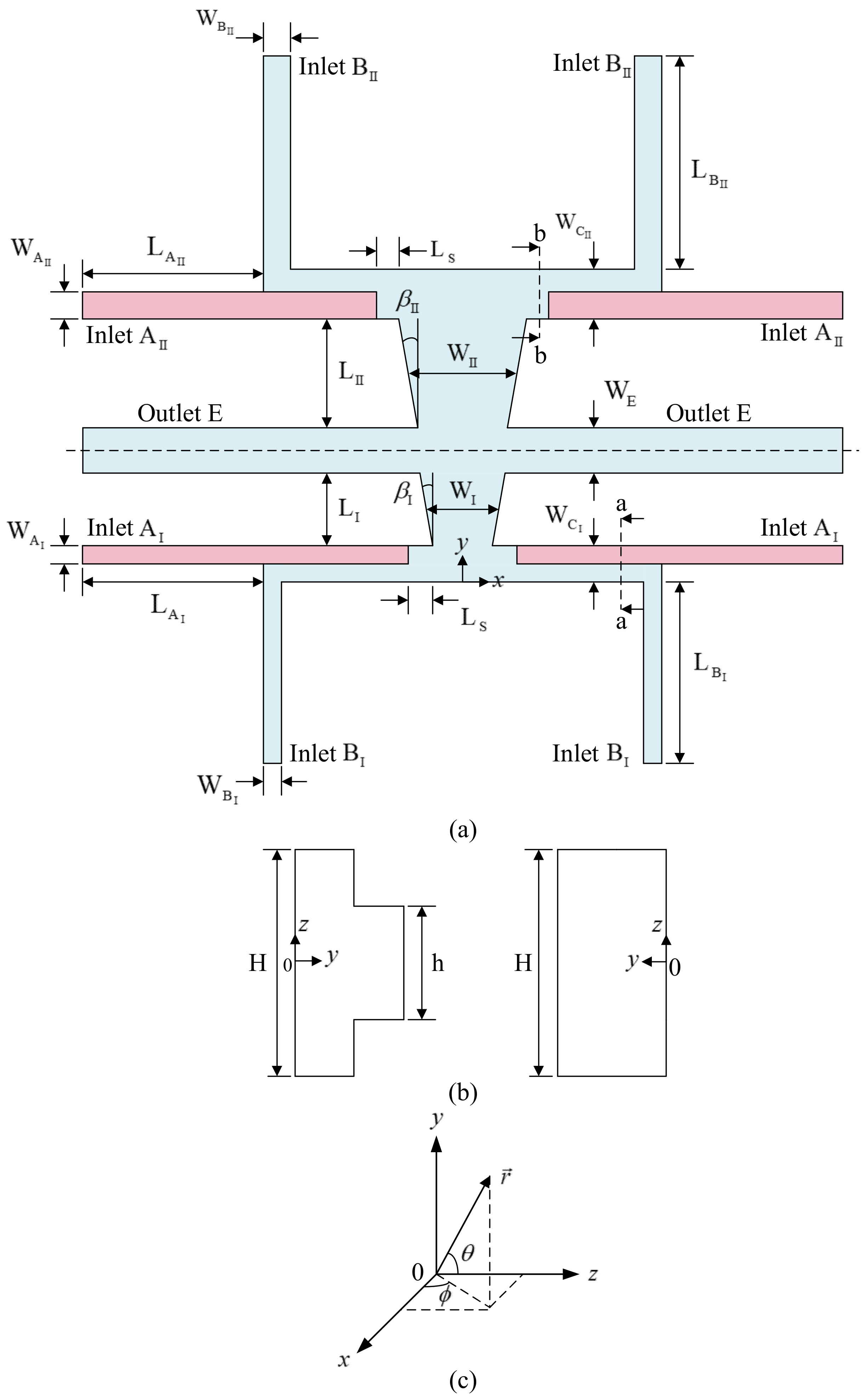


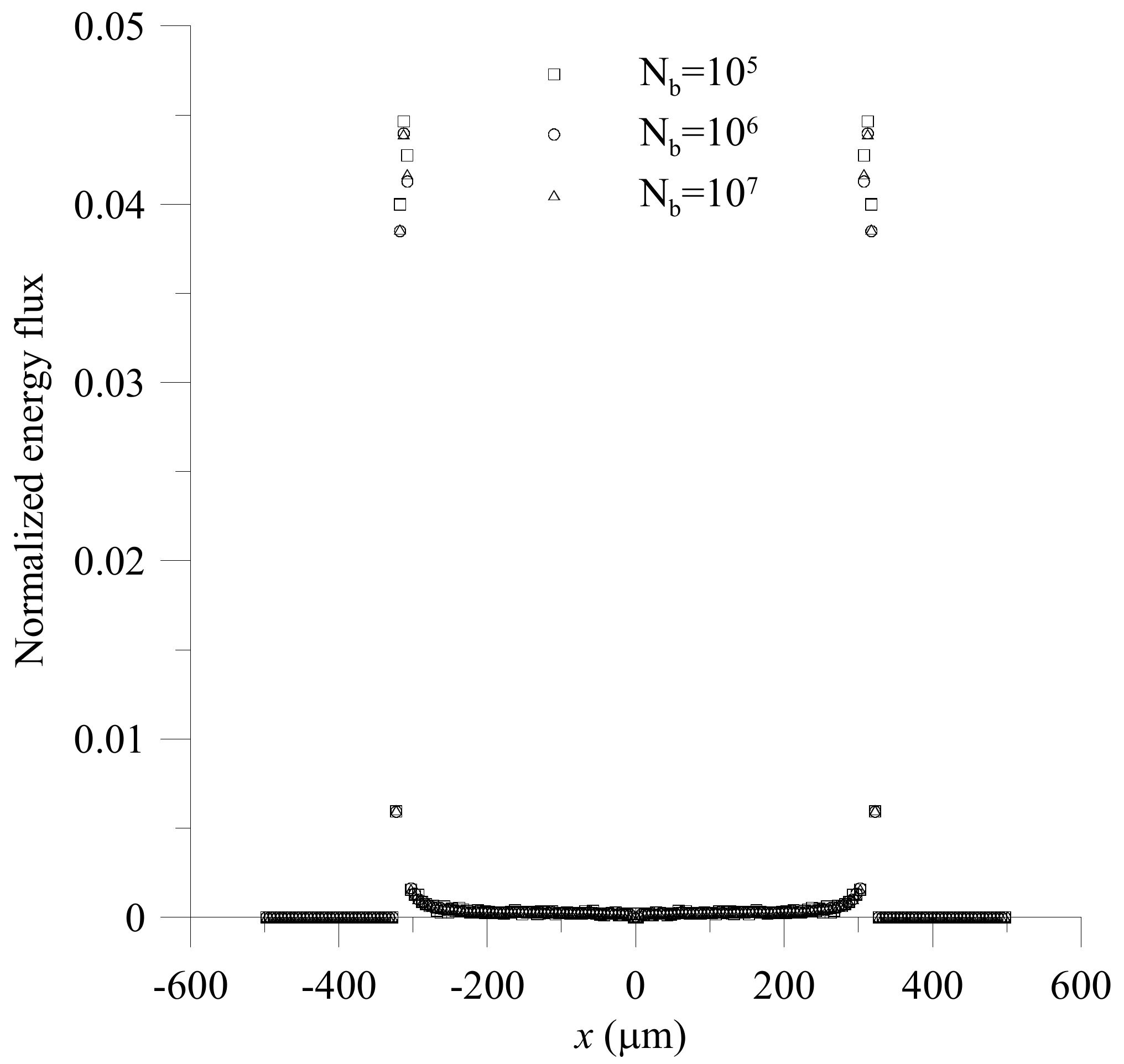


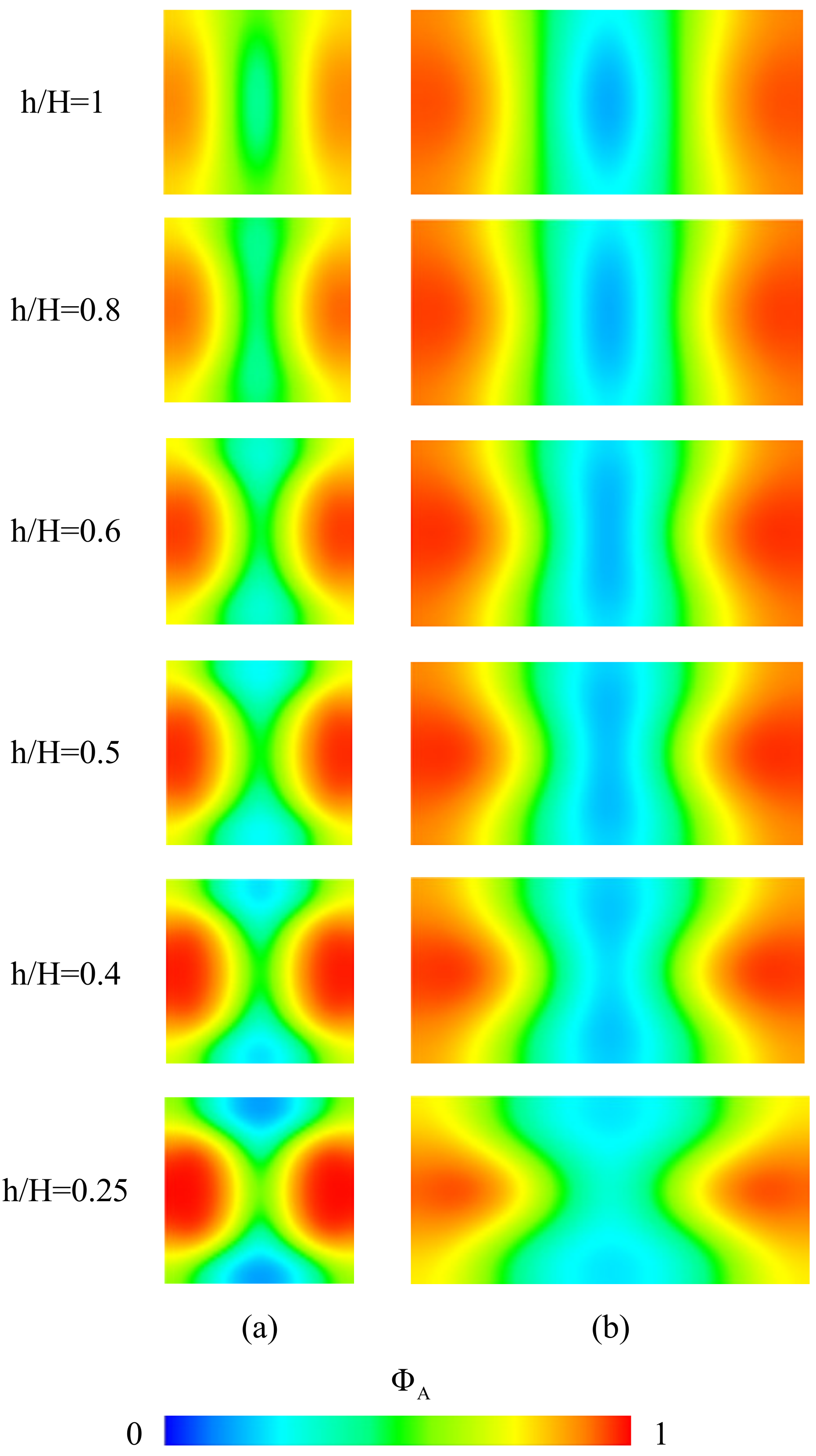
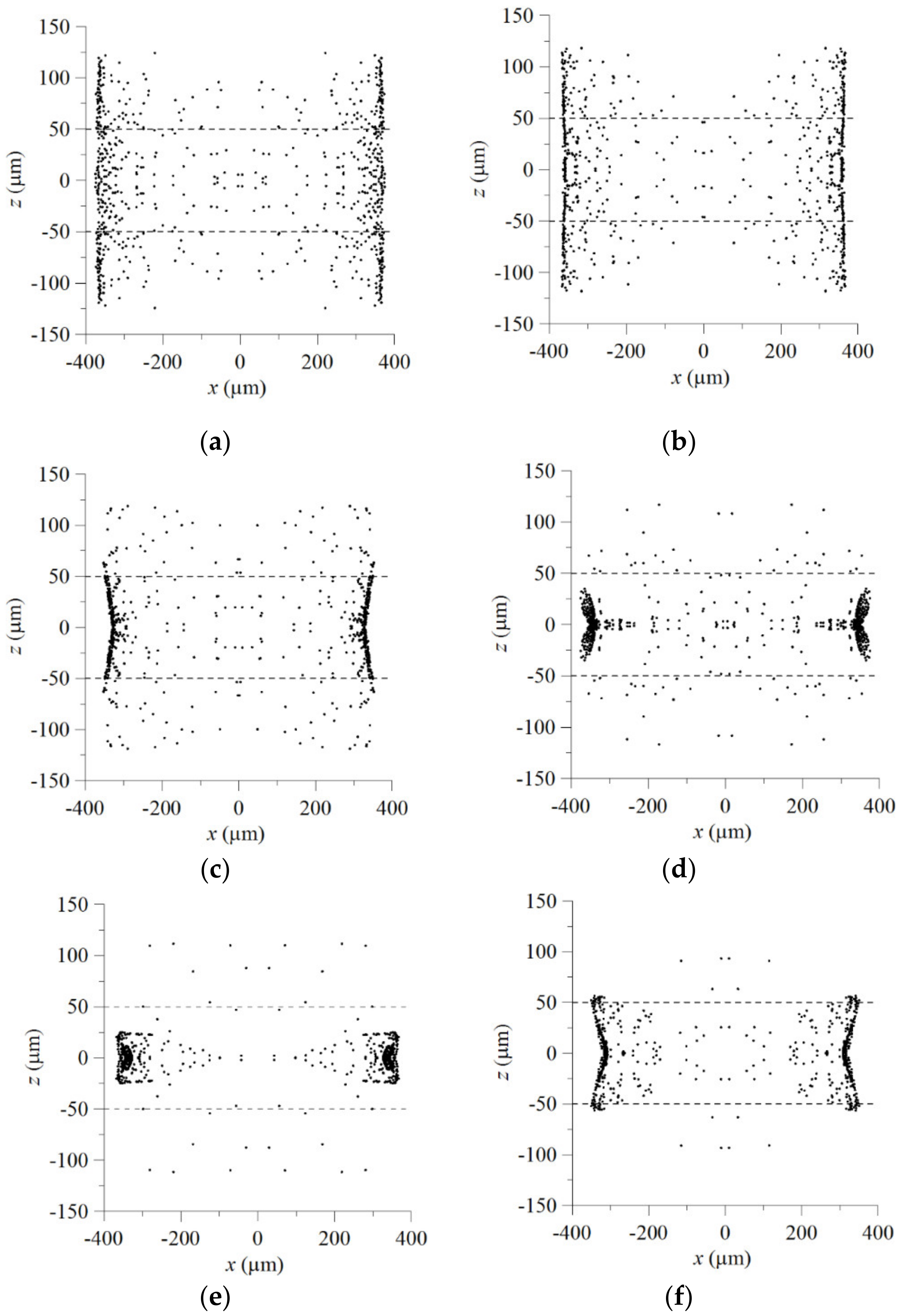

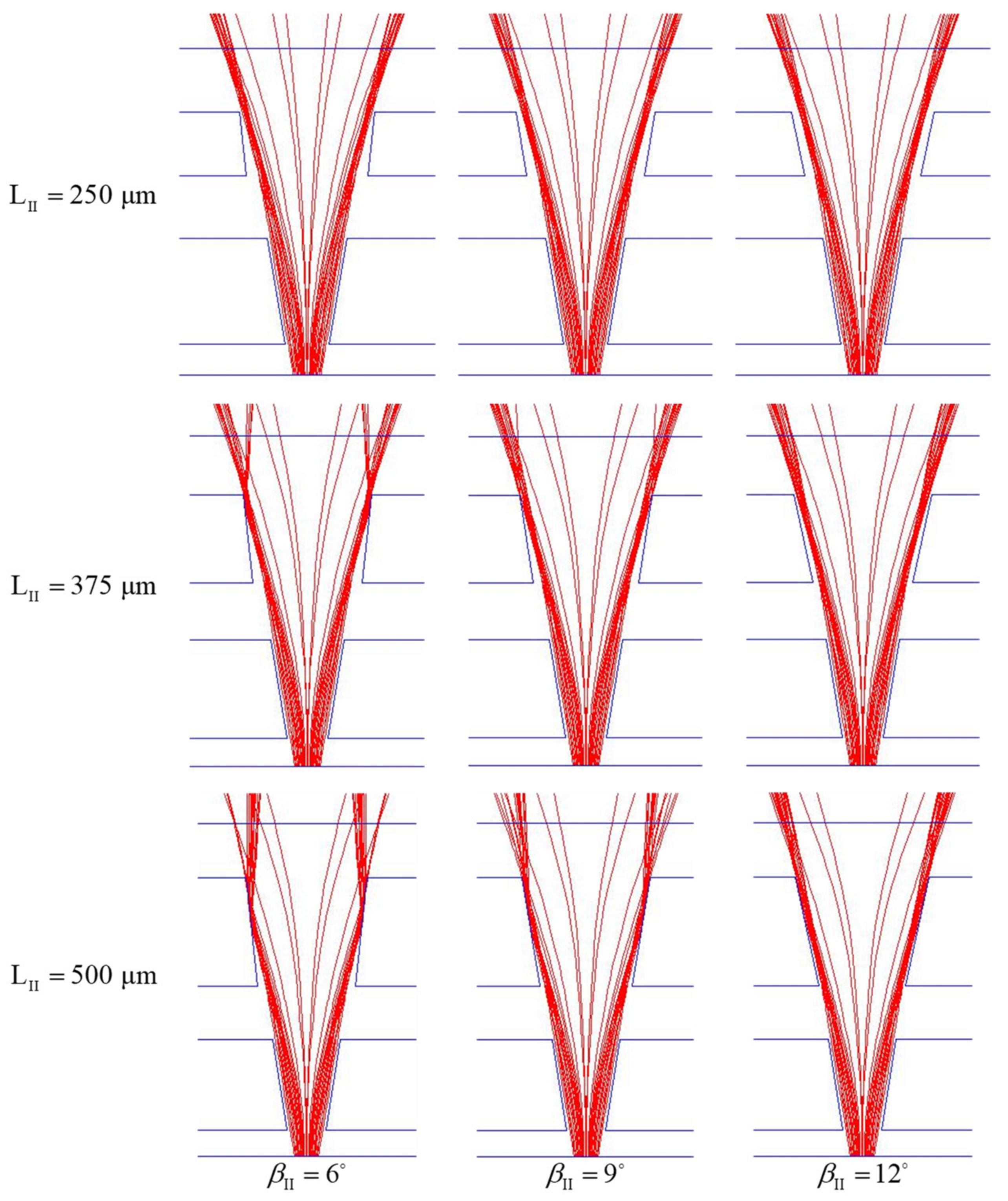

| 0.6128 | 0.4626 | |||
| 0.6118 | 0.4633 | |||
| 0.6137 | 0.4696 | |||
| 0.5532 | 0.4327 | |||
| 0.5713 | 0.4432 | |||
| 0.6110 | 0.4738 | |||
| 0.6207 | 0.4885 | |||
| 0.6201 | 0.4965 | |||
| 0.5228 | 0.4195 | |||
| 0.5868 | 0.4575 | |||
| 0.6358 | 0.5174 | |||
| 0.6369 | 0.5287 | |||
| 0.4684 | 0.3821 | |||
| 0.5585 | 0.4613 | |||
| 0.6378 | 0.5370 | |||
| 0.6592 | 0.5698 |
| 0.9504 | 0.8639 | |||
| 0.9522 | 0.8790 | |||
| 0.9517 | 0.8805 | |||
| 0.7936 | 0.7278 | |||
| 0.8974 | 0.8303 | |||
| 0.9537 | 0.8856 | |||
| 0.3034 | 0.2478 | |||
| 0.5092 | 0.4417 | |||
| 0.8370 | 0.7784 |
| 0.33 | 0.3776 | |
| 0.50 | 0.4493 | |
| 0.67 | 0.4998 | |
| 1.00 | 0.5538 | |
| 1.50 | 0.5698 | |
| 2.00 | 0.5512 |
| 0.33 | 0.7934 | |
| 0.50 | 0.8237 | |
| 0.67 | 0.8295 | |
| 1.00 | 0.8856 | |
| 1.50 | 0.8351 | |
| 2.00 | 0.8282 |
Publisher’s Note: MDPI stays neutral with regard to jurisdictional claims in published maps and institutional affiliations. |
© 2021 by the authors. Licensee MDPI, Basel, Switzerland. This article is an open access article distributed under the terms and conditions of the Creative Commons Attribution (CC BY) license (https://creativecommons.org/licenses/by/4.0/).
Share and Cite
Lin, T.-Y.; Wu, C.-Y. Numerical Investigation of a Designed-Inlet Optofluidic Beam Splitter for Split-Angle and Transmission Improvement. Micromachines 2021, 12, 1200. https://doi.org/10.3390/mi12101200
Lin T-Y, Wu C-Y. Numerical Investigation of a Designed-Inlet Optofluidic Beam Splitter for Split-Angle and Transmission Improvement. Micromachines. 2021; 12(10):1200. https://doi.org/10.3390/mi12101200
Chicago/Turabian StyleLin, Ting-Yuan, and Chih-Yang Wu. 2021. "Numerical Investigation of a Designed-Inlet Optofluidic Beam Splitter for Split-Angle and Transmission Improvement" Micromachines 12, no. 10: 1200. https://doi.org/10.3390/mi12101200





